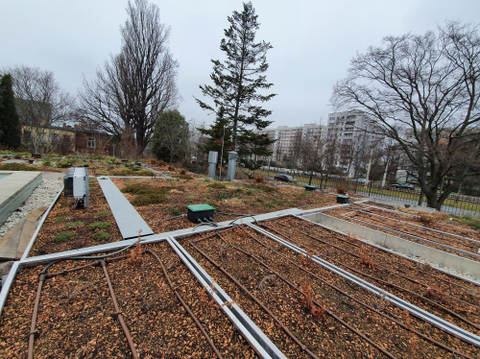Green Roof
Table of contents
Basic data
| Status | completed |
|---|---|
| Funding source | The German Federal Environmental Foundation |
| Funding reference number | Az. 35353/01-23 |
| Project term | 2020 - 2021 |
Summary

Projektlogo Green Roof
The research project investigates the effects of targeted irrigation with purified graywater on the performance of simple intensive green roofs in terms of retention capacity, evapotranspiration potential and the resulting urban climatic effects, vitality and aesthetics, as well as structural effects on the building fabric. It is also being investigated whether and how the evapotranspiration potential of a green roof can be increased by irrigation and thus its contribution to small-scale climatic enhancement.
The building climatology subproject aims to analyze the water balance of the substrate layer of the experimental green roof in the botanical garden under natural climatic conditions. In this way, it is to be determined what additional cooling potential can be expected from green roof surfaces if increased evapotranspiration is stimulated by gray water supply. The focus of the building climatology subproject is on the question of how the vapor diffusion flux density of the evapotranspiration can be described in models as a function of the greening, the substrate and the thermal insulation.
The established numerical program DELPHIN, which describes the transient coupled heat and moisture transport in capillary porous media, is predestined for the simulation. The program is applicable to building structures as well as to soils. For the implementation of the objectives, the model has to be calibrated in a first step on measured values of the experimental green roof. For this purpose, the climatic data close to the site are incorporated in high temporal resolution (e.g. hourly values).
With the calibrated simulation model, the cooling potential can be determined in the second step. For this purpose, a reference variant of the roof without green roof is analyzed under the same conditions. The differences in temperatures and heat flows on the inner surface of the roof structure provide information about the cooling capacity that could be realized by the green roof under otherwise identical conditions.
The calibrated simulation model will also be used to generalize the results obtained on the test object. The cooling potential of green roofs can be analyzed for different conditions using a matrix of variants. The variables construction structure, insulation, substrate, greening and climate are varied in ranges yet to be defined. The result is statements about the possible applications of a range of green roofs in different urban areas.
By means of preliminary simulations of the Institute for Building Climatology, the metrological concept of the experimental green roof can be optimized. Conversely, the measured values required for calibration on the test object can be supplied by the Institute of Urban and Industrial Water Management. The characteristics of the green roof and the substrate of roofs are obtained from Institute of Landscape Architecture.
Partners
Project coordination
 © IBK
© IBK
Research assistant
NameDipl.-Ing. Hans Petzold
Send encrypted email via the SecureMail portal (for TUD external users only).
